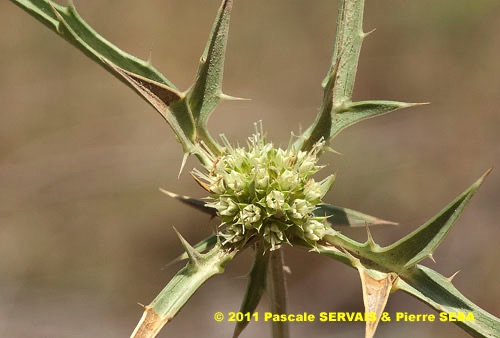
Eryngium campestre L.
Fam. : Apiaceae
© Pascale SERVAIS & Pierre SEBA, 2018. Tilo Botanica: Flore de Tilos et du Dodécanèse / Flora of Tilos and of the Dodecanese
English translation by Brenda Bradbury, Howard Bradbury and Stéphane Léonard
Plante herbacée, hermaphrodite, à tiges cannelées, ramifiées, glabres, glauques, vigoureuses.
Feuilles alternes, divisées pennatipartites à pennatiséquées, glabres, raides et coriaces, bordées d’épines, celles de la base atteignant 20 cm de long, à rachis ailé, généralement persistantes. Feuilles basales de 20 à 30 cm de long, longuement pétiolées. Feuilles caulinaires sessiles et embrassantes.
Fleurs à symétrie radiaire, blanc verdâtre ou jaune verdâtre, de 1,5 à 2,5 mm de diamètre, réunies en denses ombelles compactes, formant un dôme de 10 à 15 mm de large entouré de 4 à 7 bractées linéaires à lancéolées, de 15 à 45 mm de long, entières ou avec 1 à 2 paires d’épines latérales. Bractéoles entières. Calice à 5 sépales terminés par une fine épine. 2 styles et 2 stigmates. Ovaire infère.
Fruits, akènes ovoïdes à presque globuleux, à écailles imbriquées et terminées en pointe.
___________________________
Plant herbaceous, hermaphrodite. Stems grooved, branched, glabrous, glaucous, vigorous.
Leaves alternate, dissected pinnatipartite to pennatisect, glabrous, stiff and tough, bordered by thorns, those of the base reaching 20 cm long, with a winged midrib, generally persistent. Basal leaves from 20 to 30 cm long, lengthily petiolate. Stem-leaves sessile and clasping.
Flowers radially symmetrical, greenish white or greenish yellow, from 1.5 to 2.5 mm in diameter, joined together in dense compact umbels, forming a dome from 10 to 15 mm across surrounded by 4 to 7 linear to lanceolate bracts, from 15 to 45 mm long, entire or with 1 to 2 pairs of lateral thorns. Bracteolate entire. Calyx with 5 sepals finished by a thin thorn. 2 styles and 2 stigmas. Ovary inferior.
Fruits, ovoid to almost globose achenes, with imbricate scales finished in a point.
Descripteurs / Identifying features
1

2
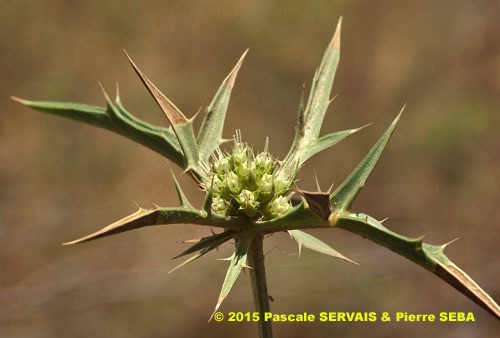
3
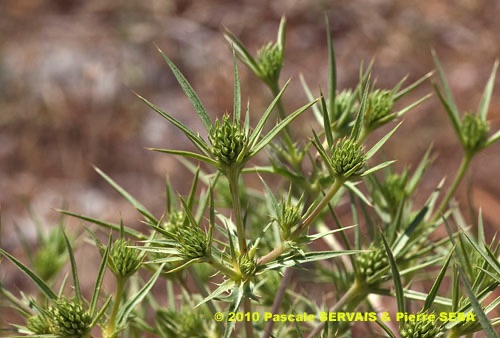
4
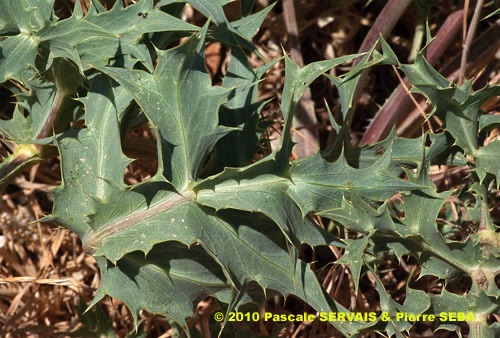
5
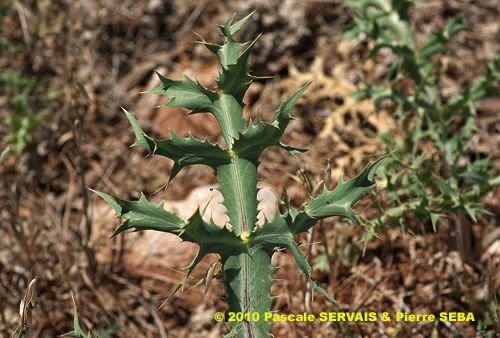
6
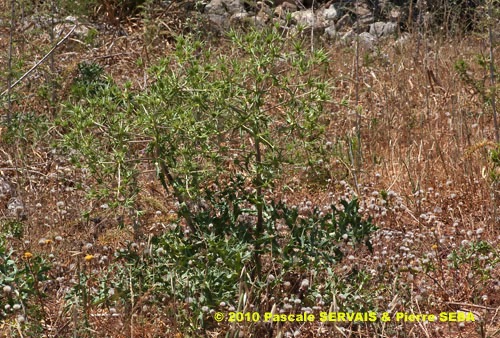
7
Étymologie / Etymology :
Eryngium : emprunt du latin eryngium, -i (nom) = le panicaut,
forme latinisée du grec ancien ἠρύγγιον, -ου (nom)
[ < ἤρυγγος, -ου (nom) = le panicaut ] = le petit panicaut, nom donné
à la plante par Théophraste, philosophe péripatéticien, disciple
d’Aristote, botaniste et naturaliste, mort vers 288 av. J.-C.
Campestre : emprunt du latin campester, -tris, -tre (adj.)
[ < campus, -i (nom) = la plaine ] = de plaine, qui pousse dans les
plaines.
Eryngium : borrowed from Latin eryngium, -i (noun) = sea holly,
Latinized form of the Classical Greek ἠρύγγιον, -ου (noun)
[ < ἤρυγγος, -ου (noun) = sea holly ] = small sea holly, name given to
the plant by Theophrastus, peripatetic philosopher, disciple of Aristotle,
botanist and naturalist, died towards 288 BC.
Campestre : borrowed from Latin campester, -tris, -tre (adj)
[ < campus, -i (noun) = plain ] = of plain, which grows in the plains.
Synonymes / Synonyms :
Eryngium amethystinum Comolli
Eryngium billardieri Marches.
Eryngium campestre subsp. contractum (Micheletti) Degen
Eryngium campestre var. littorale Rouy & E.G.Camus
Eryngium campestre var. megacephalum Pouzolz ex Des Moul.
Eryngium latifolium Hoffmanns. & Link
Eryngium officinale Garsault
Eryngium trifidum L.
Eryngium virens Link
Eryngium vulgare Lam.
Noms vernaculaires / Common names :
Noms français / French names :
Chardon-Roland — Chardon-roulant — Panicaut champêtre —
Panicaut des champs.
Noms grecs / Greek names :
Αγγαθιά — Ερύγγιον το πεδινό — Ηρύγγιον πεδινό — Μοσκαγκαθιά —
Παπαδίτσα — Σκανθοχόρτι — Σταυραγκάθι — Φειδάγκαθο.
Noms anglais / English names :
Field eryngo — Italian eryngo — Sea holly.
Noms allemands / German names :
Feld Mannstreu — Feld-Mannstreu — Krausdistel.
Noms espagnols / Spanish names :
Cardo corredor — Cardo santo — Cardo ventero.
Noms italiens / Italian names :
Calcatreppola ametistina — Calcatreppola campestre.
Habitat :
Prairies - Lieux pierreux - Chemins.
Meadows - Stony places - Waysides.
Île / Island :
Tilos.
Hauteur / Height range :
De 10 cm à 70 cm.
From 10 cm to 70 cm.
Floraison / Flowering time :
De mai à octobre.
From May to October.
Groupe / Classification :
Dicotylédones.
Dicotyledons.
Pérennité / Lifespan :
Vivace.
Perennial.
Description :
Clés dichotomiques et descripteurs distinctifs des 3 espèces / Dichotomous keys and distinctive identifying features of the 3 species
Photo 1 :
Localisation / Location : Tilos, Megalochorio, Aghios Andonis
Date : 10/06/2011
GPS : Lat. 36,45735° N / Long. 27,33130° E / Alt. 4 m
Type : Photographie numérique / Digital Photograph (10 mégapixels)
Photo 2 :
Localisation / Location : Tilos, Livadia, Aghios Stephanos
Date : 16/05/2010
GPS : Lat. 36,40781° N / Long. 27,39645° E / Alt. 11 m
Type : Photographie numérique / Digital Photograph (10 mégapixels)
Photo 3 :
Localisation / Location : Tilos, Megalochorio, Aghios Andonis
Date : 10/06/2011
GPS : Lat. 36,45735° N / Long. 27,33130° E / Alt. 4 m
Type : Photographie numérique / Digital Photograph (10 mégapixels)
Photo 4 :
Localisation / Location : Tilos, Livadia, Aghios Stephanos
Date : 16/05/2010
GPS : Lat. 36,40771° N / Long. 27,39645° E / Alt. 11 m
Type : Photographie numérique / Digital Photograph (10 mégapixels)
Photo 5 :
Localisation / Location : Tilos, Livadia, Aghios Stephanos
Date : 16/05/2010
GPS : Lat. 36,40771° N / Long. 27,39645° E / Alt. 11 m
Type : Photographie numérique / Digital Photograph (10 mégapixels)
Photo 6 :
Localisation / Location : Tilos, Livadia, Aghios Stephanos
Date : 16/05/2010
GPS : Lat. 36,40771° N / Long. 27,39645° E / Alt. 11 m
Type : Photographie numérique / Digital Photograph (10 mégapixels)
Photo 7 :
Localisation / Location : Tilos, Livadia, Aghios Stephanos
Date : 16/05/2010
GPS : Lat. 36,40781° N / Long. 27,39645° E / Alt. 11 m
Type : Photographie numérique / Digital Photograph (10 mégapixels)

Google Maps
Google Maps
Google Maps
Google Maps
Google Maps
Google Maps
Google Maps